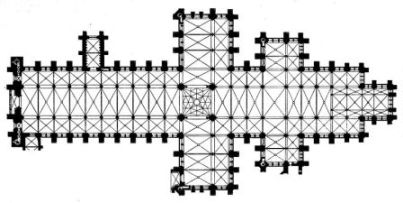Cathedrals In The Middle Ages
Center Ages
Catholic Church and Cathedrals
History >> Middle Ages for KidsChristianity and the Catholic Church played a major office in Europe during the Middle Ages. The local church was the center of town life. People attended weekly ceremonies. They were married, confirmed, and buried at the church. The church fifty-fifty confirmed kings on their throne giving them the divine right to rule.

Wells Cathedral by Adrian Pingstone
Rich and Powerful
The Catholic Church building became very rich and powerful during the Eye Ages. People gave the church 1/10th of their earnings in tithes. They too paid the church for various sacraments such as baptism, spousal relationship, and communion. People also paid penances to the church building. The wealthy oft gave the church building land.
Eventually, the church owned nearly 1 third of the land in Western Europe. Because the church building was considered contained, they did non have to pay the male monarch whatsoever tax for their land. Leaders of the church became rich and powerful. Many nobles became leaders such every bit abbots or bishops in the church building.
Structure of the Church building
The leader of the Catholic Church was the pope. Correct below the pope were powerful men chosen cardinals. Adjacent were bishops and abbots. Fifty-fifty bishops held a lot of ability on the local level and oft served on the council of the king.
Cathedrals
Many churches were congenital during the Middle Ages. The biggest of these churches were called cathedrals. Cathedrals were where bishops had their headquarters.
Cathedrals were built to inspire awe. They were the most expensive and cute buildings congenital. Sometimes construction on a cathedral could have two hundred years to finish.
Well-nigh cathedrals were congenital in a like fashion. They generally were laid out in the shape of a cross. They had very tall walls and loftier ceilings.

Layout of a cathedral in the shape of a cross by Unknown
Gothic Architecture
Around the 12th century, cathedrals began to be built with a new style of compages called Gothic compages. With this style, the weight of the vaulted ceilings rested on buttresses rather than on the walls. This manner the walls could be thinner and taller. It also immune for tall windows on the walls.
Art
Some of the swell fine art of the Center Ages was produced in cathedrals. This included stained drinking glass windows, sculpture, architecture, and painted murals.
Other Religions
Although Christianity dominated Europe during the Middle Ages, at that place were other religions. These included heathen religions such as the Viking worship of the god Thor. Other religious groups included the Muslims, which ruled much of Espana for many years, and the Jews, which lived throughout many cities in Europe. The Jews played a significant role in the economy because they were allowed to loan money and accuse interest.
Interesting Facts about the Catholic Church building and Cathedrals
- Conversion of a land generally took identify from the king down. In one case the rex was converted to Christianity, his nobles and people followed arrange.
- Some main masons were able to work on a single cathedral for their entire life.
- Cathedrals and churches were often used for coming together places when a large location was needed.
- Catholic Bishops oftentimes sat on the male monarch'due south quango.
- Churches provided education and looked later the poor and the sick.
- The primary trunk of a cathedral is called the "nave", the ends of the cantankerous department are chosen the "transepts", and the entrance is called the "narthex".
- Have a 10 question quiz about this page.
- Listen to a recorded reading of this folio:
More subjects on the Middle Ages:
Works Cited
History >> Center Ages for Kids
Cathedrals In The Middle Ages,
Source: https://www.ducksters.com/history/middle_ages/catholic_church_cathedrals.php
Posted by: donaldsonmucland.blogspot.com


0 Response to "Cathedrals In The Middle Ages"
Post a Comment